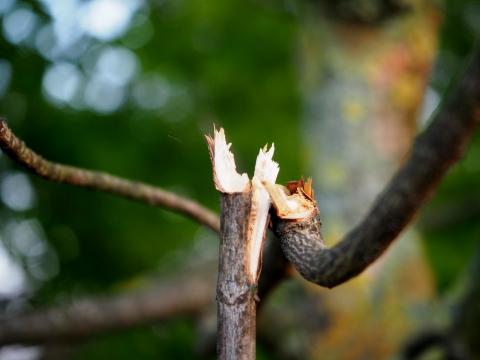Is there any way to save a branch that broke off of one of my trees?

It’s not uncommon for trees and shrubs to suffer broken limbs during storm events, and home gardeners are often curious if there is a way to reattach or take cuttings from branches. Though these methods are sometimes successful, they require a lot of knowledge and patience, and in the majority of cases aren’t worth the effort.
Pruning out broken branches usually helps trees and shrubs in the long run. If there are still plenty of remaining branches along the trunk, these will grow more vigorously as the tree tries to replace what it lost. With careful pruning, it is often possible to train limbs to fill in a blank area.
It is rarely possible to successfully reattach broken limbs. Trying to cable or tie them back to the main trunk is almost always wasted energy. Unlike people, woody plants are unable to heal damaged tissues. Instead, they compartmentalize wounds with layers of cells that prevent the damage from spreading any further. Thus, the damaged wood does not grow back together again, and even if the branch manages to survive, it will be very weak because its vascular systems has been severely compromised. Additionally, it will never be possible to remove the ties or cables that hold a broken branch in place, which could mean a permanent eyesore in the landscape.
Some gardeners may also wonder if it is possible to root a broken branch. Sadly, large branches cannot be rooted in their entirety, but a few small twig cuttings may be salvageable. While it is possible to grow many types of trees and shrubs from cuttings, it is no easy task.
Very few species will root from cuttings that are stuck directly into the ground. It is almost always necessary to pot them up and use rooting hormones and some type of propagation chamber to keep humidity high. A greenhouse with a misting bench is ideal, though lower-tech options such as putting potted cuttings inside of a clear plastic bag or using trays with clear plastic high-domed lids can sometimes work too.
To complicate matters further, trees and shrubs have optimum stages of wood maturity for rooting stem cuttings: softwood, semi-hardwood and hardwood. Softwood cuttings are taken from new, tender growth in the spring through the early summer. Semi-hardwood cuttings come from current season’s growth just after the growth flush and hardwood cuttings are taken from mature, dormant stems in the late fall, winter or spring. Many trees and shrubs can only be successfully propagated during one of these growth phases.
Birch cuttings, for example, are most likely to root if they are taken at the softwood stage of maturity. So, if a birch branch breaks off in May or June, it might be possible to get a few cuttings to root, but rooting is unlikely if the branch were to fall in the late summer or winter. The key to success is knowing exactly which tree or shrub you have and following research-based propagation guidelines for that particular species.
All in all, when a tree or shrub has a broken branch, it is almost always easier to cut your losses and remove it. As long as the trunk and the majority of the main branches are still intact, the plant will recover.
If you are considering using a tree wound dressing to help heal the wound, read this related question of the week.
Do you love learning about stuff like this?
SUBSCRIBE TO GRANITE STATE GARDENING
A monthly newsletter for New Hampshire gardeners, homesteaders and plant-lovers of all kinds, that includes seasonal suggested gardening tips, upcoming events and articles with proven solutions for your garden and landscape.
Got questions? The Ask UNH Extension Infoline offers practical help finding answers for your home, yard, and garden questions. Call toll free at 1-877-398-4769, Monday to Friday, 9 a.m. to 2 p.m., or e-mail us at answers@unh.edu.

